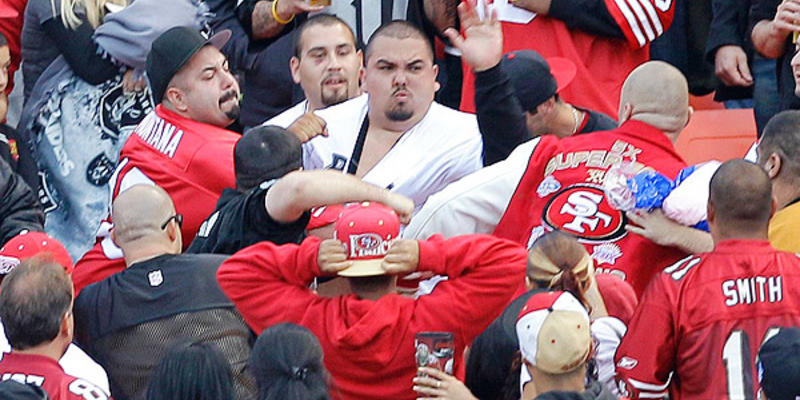

Sports have become one the most cherished forms of entertainment in today’s world. Me, I love sports. I write about, argue over, cheer for, and play sports. Sports are not only entertaining, but also useful in situations like breaking the ice with a stranger, catching up with an old friend, or even acing a job interview. And, with the demand for sports at a peak premium, the industry is providing jobs and entertainment for masses of people.
Yet, for some reason, the surge in the popularity of sports has been accompanied by extreme and unpredictable fan violence.
Last week, HBO’s Real Sports with Bryant Gumbel ran a story about this fan-on-fan violence. In the segment, Gumble and his crew investigated the trend of fan violence around the country, which has left a number of people seriously injured or dead. The story highlighted instances in which fans were brutally beaten for wearing the wrong colors or jerseys in the wrong stadium, reminding me of the History Channel show Gangland, which often depicts gangs killing innocent people for wearing colors that represent rival gangs. Needless to say, I continued to think about this fan-on-fan violence long after I switched off the TV for the evening.
As I lay in bed… I wondered why we fans act so crazy at games. Why do we insist on cursing and verbally demoralizing opposing fans and teams? Why has a Sunday with Dad at the football stadium transformed from joyful cheers to swarms of swears that would offend even the hardest king crab fishermen in the Bering Sea? Why is the thought of getting punched in the face or having to punch someone else in the face at next week’s USC-Georgia game even going through my head right now?
Well, there’s always the concept that sports are inherently violent—a sort of surrogate war with semi-violent competition in place of killing. Perhaps fan violence is a spillover from violent sports like football, boxing, or hockey, and fan-on-fan violence is just an imitation of what their favorite athletes do on the field. After all, this aggression can be traced back to the Roman days when riots and fighting were inevitable after a bloody chariot race or gladiator bout. Ask Russell Crow: the more blood, the more entertainment.
OR—could fan violence be more of a cultural issue? Think about the good-old moneymaking BCS College football… From the moment a college kid walks onto campus, they are taught to identify with the institution and represent their university with pride. At these vulnerable ages (18- to 22-year-olds, that is, I’m not talking about the dedicated 40-year-old with 10 sad stories), the importance of being “cool” and identifying with a group takes precedent over superfluous issues, like, say… grades. Academic ambition aside, college sporting events (primarily football games) are true breading grounds for fan violence…
After tailgating (which, in college terms, means liquor luges and beer bongs, not hotdogs and hamburgers) for hours, how can you blame the vodka-soaked 18-year-old freshman for representing his Georgia Bulldogs by barking in a rival fans face? Yeah, the rival fan may have been a nine-year-old girl with pigtails and rosy cheeks, but who cares? His friends laughed and…. GO BULLDOGS! And, in the process, he became a true Bulldog fan.
This trend, obviously, goes beyond the BCS, too. In college, I fell hard for the Philadelphia sports camaraderie when the Phillies won the 2008 World Series. After a crazy Game 5, which was suspended by rain for over a day, the Phillies eeked out a 4-3 victory over the Tampa Bay Rays to win it all. In Philly Phanatic fashion, I began to riot in the streets with thousands of other Phillies fans. Wet with wine, we fanatics began burning couches on the street, fist fighting, and once the police showed up, being pepper sprayed—all in the glorious celebration of victory.
The next week, I apparently still felt the buzz from my championship Phillies. I needed to open a bank account, and when doing so was offered to have the Phillies logo embroidered on my brand new credit card. “Hell yeah! Go Phillies,” I said with a nod. Now, four years later, I still have my Phillies Bank of America card, and despite not knowing more than a half dozen players on the current team, I will always be a Philly fan.
So why was I so enthralled by the Phillies? It was all about identity, about being a part of Philly fandom (although I don’t really think they would accept me considering I just confessed my lack of Phillies knowledge). I didn’t necessarily love Philly sports, but what I did love were the Philly sports fanatics, their passion, and the all-around badass sports identity. Sports provide this ultimate medium for people wanting to identify with groups. Fan violence is this sort of byproduct of needing to uphold their group’s reputation and ultimately wanting to protect their group. When our group’s identity is tested by a loss, threatened by opponents, or fueled by alcohol (or, best case scenario: a combination of all three), the result is often fan violence (exhibit A).
In-studio, passionate yet insightful arguments on popular sports shows such as ESPN's First Take are funny, entertaining, and slightly informative. The same argument that is glorified by the ESPN talking heads could easily become violent if it were to occur among today’s sports fans. Sprinkle in a few tequila shots by both parties and a cordial disagreement can quickly turn into fans reverting to that need to protect their group. And what better and more convincing way to do so than with fists?